
Arianism is a Christological doctrine first attributed to Arius, a Christian presbyter in Alexandria, Egypt. Arian theology holds that Jesus Christ is the Son of God, who was begotten by God the Father. The Arian concept of Christ is based on the belief that the Son of God did not always exist but was begotten within time by God the Father, therefore Jesus was not co-eternal with God the Father. Arianism holds that the Son is distinct from the Father and therefore subordinate to Him. The term Arian is derived from the name Arius; it was not what the followers of Arius's teachings called themselves, but rather a term used by outsiders. The nature of Arius's teachings and his supporters were opposed to the theological doctrines held by Homoousian Christians, regarding the nature of the Trinity and the nature of Christ.

Christianity is an Abrahamic, monotheistic religion based on the life and teachings of Jesus of Nazareth. It is the world's largest religion, with about 2.4 billion followers. Its adherents, known as Christians, make up a majority of the population in 157 countries and territories, and believe that Jesus is the Christ, whose coming as the Messiah was prophesied in the Hebrew Bible and chronicled in the New Testament.

The Eastern Orthodox Church, officially the Orthodox Catholic Church, is the second-largest Christian church, with approximately 220 million baptised members. It operates as a communion of autocephalous churches, each governed by its bishops in local synods. The church has no central doctrinal or governmental authority analogous to the bishop of Rome (Pope), but the ecumenical patriarch of Constantinople is recognised by all bishops as primus inter pares and regarded as the representative and spiritual leader of Eastern Orthodox Christians. As one of the oldest surviving religious institutions in the world, the Eastern Orthodox Church has played a prominent role in the history and culture of Eastern and Southeastern Europe, the Caucasus, and the Near East.

Theotokos is a title of Mary, mother of Jesus, used especially in Eastern Christianity. The usual Latin translations are Dei Genitrix or Deipara. Familiar English translations are "Mother of God" or "God-bearer" – but these both have different literal equivalents in Greek, Μήτηρ Θεοῦ and Θεοφόρος.
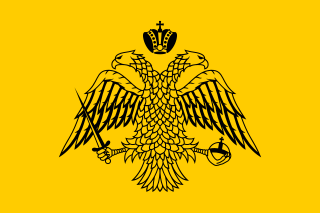
The name Greek Orthodox Church, or Greek Orthodoxy, is a term referring to the body of several churches within the larger communion of Eastern Orthodox Christianity, whose liturgy is or was traditionally conducted in Koine Greek, the original language of the Septuagint and the New Testament. Its history, traditions, and theology are rooted in the early Church Fathers and the culture of the Byzantine Empire. Greek Orthodox Christianity has also traditionally placed strong emphasis on and awarded high prestige to traditions of Eastern Orthodox monasticism and asceticism, with origins in Early Christianity in the Near East and in Byzantine Anatolia.
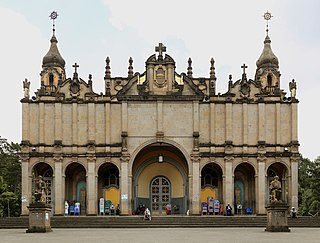
The Ethiopian Orthodox Tewahedo Church is the largest of Eastern Christianity's branch of Oriental Orthodox Christian churches. One of the few Christian churches in Sub-Saharan Africa originating before European colonization of the continent, the Ethiopian Orthodox Tewahedo Church dates back millennia, and has a current membership of about 36 million people, the majority of whom live in Ethiopia. It is a founding member of the World Council of Churches. The Ethiopian Orthodox Tewahedo Church is in communion with the Eritrean Orthodox Tewahedo Church, the Coptic Orthodox Church of Alexandria, the Malankara Orthodox Syrian Church, the Armenian Apostolic Church and the Syriac Orthodox Church, having gained autocephaly in 1959.

Nontrinitarianism is a form of Christianity that rejects the mainstream Christian doctrine of the Trinity—the belief that God is three distinct hypostases or persons who are coeternal, coequal, and indivisibly united in one being, or essence. Certain religious groups that emerged during the Protestant Reformation have historically been known as antitrinitarian.

A Christian denomination is a distinct religious body within Christianity that comprises all church congregations of the same kind, identifiable by traits such as a name, peculiar history, organization, leadership, theological doctrine, worship style and sometimes a founder. It is a secular and neutral term, generally used to denote any established Christian church. Unlike a cult or sect, a denomination is usually seen as part of the Christian religious mainstream. Most Christian denominations self-describe as Churches, whereas some newer ones tend to use the terms churches, assemblies, fellowships, etc., interchangeably. Divisions between one group and another are defined by authority and doctrine; issues such as the nature of Jesus, the authority of apostolic succession, biblical hermeneutics, theology, ecclesiology, eschatology, and papal primacy may separate one denomination from another. Groups of denominations—often sharing broadly similar beliefs, practices, and historical ties—are sometimes known as "branches of Christianity". These branches differ in many ways, especially through differences in practices and belief.

The Latter Day Saint movement is the collection of independent church groups that trace their origins to a Christian Restorationist movement headed by Joseph Smith in the late 1820s.
Black Hebrew Israelites are groups of African Americans who believe that they are the descendants of the ancient Israelites. To varying degrees, Black Hebrew Israelites incorporate certain aspects of the religious beliefs and practices of both Christianity and Judaism, though they have created their own interpretation of the Bible. Many choose to identify as Hebrew Israelites or Black Hebrews rather than Jews in order to indicate their claimed historic connections.
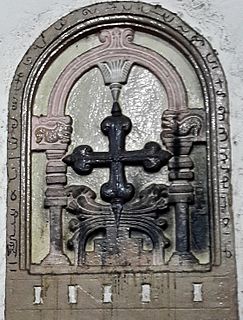
The Synod of Diamper , held at Udayamperoor in 1599, was a diocesan synod, or council, that created rules and regulations for the ancient Saint Thomas Christians of the Malabar Coast, a part of modern-day Kerala state, India, formally subjugating them and their whole Metropolitanate of India, which was mainly based in modern Kerala to the Archdiocese of Goa administered by Roman Catholic Padroado missionaries. This led to the permanent schism among the Thomas' Christians of India after 53 years, leading to the formation of Puthenkoor and Pazhayakoor factions.
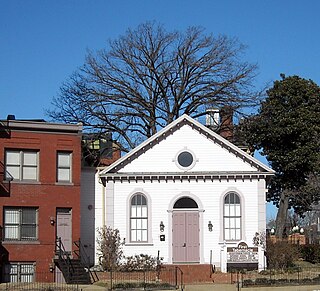
The Church of God and Saints of Christ is a Black Hebrew Israelite religious group established in Lawrence, Kansas, by William Saunders Crowdy in 1896. William Crowdy began congregations in several cities in the Midwestern and Eastern United States, and sent an emissary to organize locations in at least six African countries. The congregation later established locations in Cuba and the West Indies.
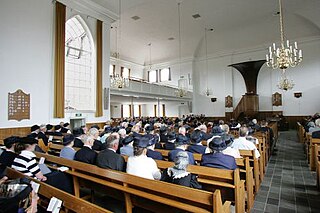
A church is a religious organization or congregation that meets in a particular location. Many are formally organized, with constitutions and by-laws, maintain offices, are served by clergy or lay leaders, and, in nations where this is permissible, often seek non-profit corporate status.
William Saunders Crowdy was an American soldier, preacher, entrepreneur, theologian, and pastor. As one of the earliest Hebrew Israelites in the United States, he established the Church of God and Saints of Christ in 1896 after he claimed to have had visions telling him "that Blacks were descendants of the twelve lost tribes of Israel."
Eastern Orthodox theology is the theology particular to the Eastern Orthodox Church. It is characterized by monotheistic Trinitarianism, belief in the Incarnation of the essentially divine Logos or only-begotten Son of God, a balancing of cataphatic theology with apophatic theology, a hermeneutic defined by a polyvalent Sacred Tradition, a concretely catholic ecclesiology, a robust theology of the person, and a principally recapitulative and therapeutic soteriology.

The Oriental Orthodox Churches are a group of Eastern Christian churches adhering to Miaphysite Christology, with a total of approximately 60 million members worldwide. The Oriental Orthodox Churches are broadly part of the trinitarian Nicene Christian tradition shared by today’s mainstream churches, and represent one of its oldest branches.
The expression "one true church" refers to an ecclesiological position asserting that Jesus gave his authority in the Great Commission solely to a particular Christian institutional church— what others would call a denomination, believers of this doctrine consider pre-denominational. This view is maintained by the Catholic Church, the Lutheran Church, the Episcopalian Church, the Eastern Orthodox Church, the Oriental Orthodox communion, the Assyrian Church of the East, the Ancient Church of the East and the Churches of Christ. Each of them maintains that their own specific institutional church (denomination) exclusively represents the one and only original church. The claim to the title of the "one true church" relates to the first of the Four Marks of the Church mentioned in the Nicene Creed: "one, holy, catholic, and apostolic church". As such, it also relates to claims of both catholicity and apostolic succession: asserting inheritance of the spiritual, ecclesiastical and sacramental authority and responsibility that Jesus Christ gave to the apostles.

A sacrament, is a Christian rite recognized as of particular importance and significance. There are various views on the existence and meaning of such rites. Many Christians consider the sacraments to be a visible symbol of the reality of God, as well as a channel for God's grace. Many denominations, including the Catholic, Lutheran, Anglican, Methodist, and Reformed, hold to the definition of sacrament formulated by Augustine of Hippo: an outward sign of an inward grace, that has been instituted by Jesus Christ. Sacraments signify God's grace in a way that is outwardly observable to the participant.











